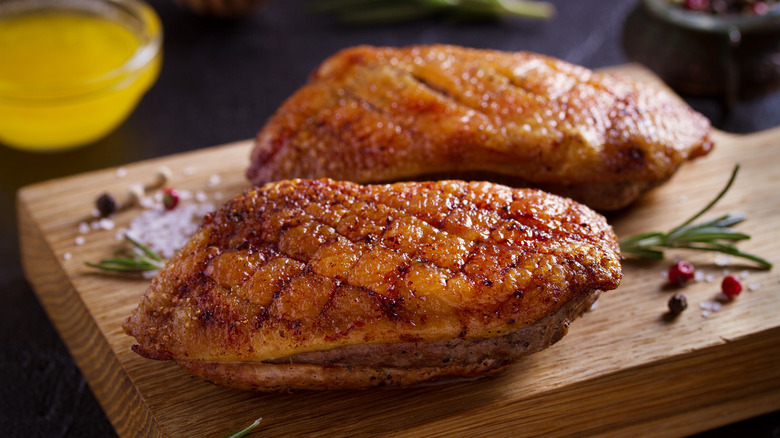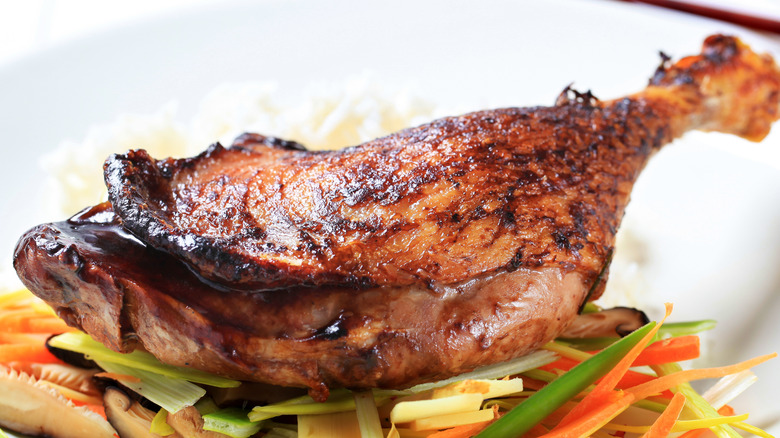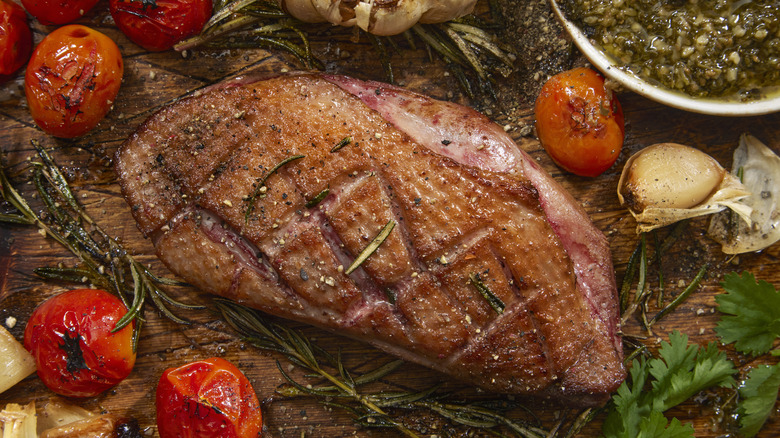When It Comes To Duck Meat, A Dry Brine Is The Way To Go
The perfectly golden, crispy skin that gives way to succulent medium-rare duck meat brings many people flocking to the table. To achieve that desired result, controlling moisture is key, and using a dry brine is crucial to moisture control. A dry brine is a combination of salt, sugar, spices, and other ingredients sprinkled or patted over the surface of meat, in this case, the duck skin. Left on the duck or other protein from several hours up to a couple of days, the brining mixture helps to draw out moisture from the skin layer.
With duck meat, the skin tends to be thick, with a generous fat layer. To help ensure the skin renders well and you don't end up with greasy duck, the excess moisture needs to be removed, which the dry brine accomplishes. If you have put a wet, damp, or otherwise moist protein into a hot pan, you likely know that it probably won't brown. Dry surfaces can achieve that highly sought-after browning known as the Maillard Reaction. As the brine mixture sits on the duck skin, water is drawn out and can be dried off before the duck hits the heat. When perfectly moist duck meat is what you desire, a generous helping of salt is the first step to enjoying that succulent bite.
Why is a dry brine better than a wet brine for duck meat?
To reduce the duck's gamey, iron-rich flavor, and increase the tenderness of the meat, duck meat needs to be brined. The pros and cons of dry brining versus wet brining can cause heated conversations in the kitchen, but the brining choice for duck meat is usually not as divisive. As the name indicates, a dry brine is salt and other dry spices applied to the surface of the protein, whereas a wet brine submerges the food into a liquid solution. Although both methods impart flavor and can help to maintain moisture during cooking, giving poultry a bath in a liquid brine may not be the best choice. Over-brining duck, which is a risk with liquid brines, can actually result in a chewy, dry texture.
With the dry brining, however, the duck and the salt mixture can sit longer without over-brining the meat. This allows not only the skin to dry out but also the muscle fibers to break down. The result is a more tender bite when the duck is then cooked properly. So while proper brining is one of the secrets to making a succulent duck, avoid a splash landing into a pot of wet brine if you want to serve your guests a moist duck.
What is the best way to prepare a dry brine for duck?
Although the poultry won't be taking a plunge into a seasoned, water bath, a dry brine for a duck will similarly benefit from the most flavorful ingredients. First and foremost, kosher salt is an essential component to the mix. The coarse texture makes it easier to see how the granules are covering the meat's surface. In contrast, a thick flake, finishing salt is too dense and a fine table salt could lead to over salting. Unlike the old adage about properly salting pasta water to the salinity of the sea, the salt in a dry brine should not become a salt lick. Balance is key.
Sugar often joins salt in the brine mixture. That ingredient helps to enhance caramelization during cooking. But, the sugar is a supporting flavor to the kosher salt. The predominant ingredient in a dry brine should always be salt.
In addition, dried herbs and seasonings can enhance the mix. From a subtle Herbs de Provence to a robust Chinese five spice, hitting the salty, sweet, bitter, sour, and even umami notes can make for an enjoyable flavor. For a crispy skin, juicy duck that gets people flocking to the table, sprinkle on the dry brine and bask in the rave reviews.


